Welcome to week 3: Dataveillance, Biometrics & Facial Recognition
Week three of the selfie course is about machine audiences for our selfies. Although most of us make selfies imagining other humans – or maybe just yourself – as the primary audience, our selfies are also viewed and interpreted by machines.
Lev Manovich his team’s Selfiecity.net is a great place to start exploring what biometrics means for our online self-representations. They used biometric facial expression recognition to compare selfies from different cities around the world. Poke around the site a bit. Use the Selfiexploratory to curate your own selections of selfies from their data.

Then, read Liz Losh’s essay critiquing the use of biometrics and querying what this kind of research can really tell us.
Selfies are photos we take ourselves, usually of our own free will. Sometimes we are forced to be photographed (photos for drivers licences or passports, police mugshots, immigration photos) or we are photographed without knowing it (surveillance cameras, stalkers, paparazzi). Sometimes we find ways to share our images or writing with our friends but not the authorities, or with humans but not machines, for instance using what danah boyd and Alice Marwick call social stenography in one of the readings for this week. Visuals forms of social steganography might include nudes where the head and other identifying features are cropped out, or CV Dazzle

makeup to make a human face unrecognizable to facial recognition software.
You have a few different choices for you image assignments for this week:
- Find one of the categories of biometric analysis (gender, age, weight, race, etc.) and shoot a photo that you think might “fool” a non-human audience member into interpreting you as different from the way you typically present.
- Photograph yourself in a way in which facial recognition software or similar techniques would not be able to identify as you, but that still expresses something meaningful about you.
- Locate all of the cameras in your home, campus, workplace, neighborhood, or community and shoot a series of “sousvies” in which you shoot an image of yourself with a surveilling device — overhead camera in checkout line, camera in ATM machine, etc. — in the frame. How might the gaze of the device see you differently? Could you stage a “survie” that shows how cameras see you when you aren’t conscious of the fact that they are taking your picture? (Tip: Do not do this activity in places where photographing these technologies may be forbidden, such as airports or banks.)
Please post the image(s) you take to our Flickr group along with a descriptive and reflective text describing the choices you made when taking the images. Why this image? How does this kind of self-representation work? How do machines see you differently to the way you see yourself? You can also comment on this blog post to take part in the discussions.
Here is the full text of the syllabus for this week, including readings, discussion topics, image assignments and a reflection essay prompt. If you are following this course online, without being part of an existing class guided by a teacher, just focus on the image assignments.
Leave a Reply